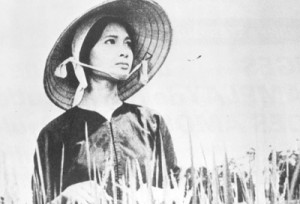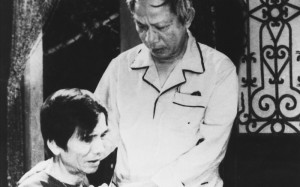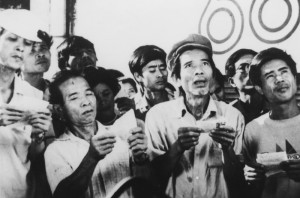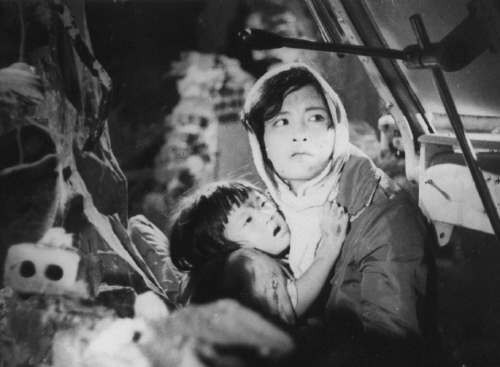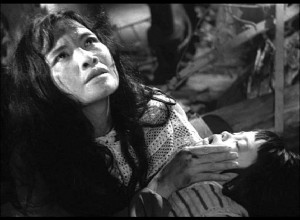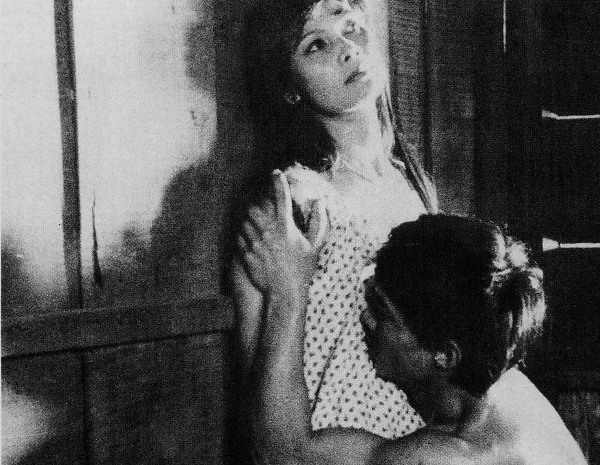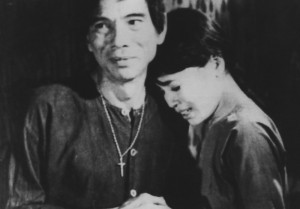From the Chicago Reader (May 13, 1994). I’m delighted that stills from these and other Vietnamese films have finally become available on the Internet — which didn’t appear to be the case in October 2010, when I participated in a panel related to the first of these films in Washington, D.C. — J.R.
*** THE LITTLE GIRL OF HANOI
(A must-see)
Directed by Hai Ninh
Written by Hoang Tich Chi, Hai Ninh, and Vuong Dan Hoang
With Lan Huong, Tra Giang, The Anh, and Kim Xuan.
*** THE GIRL ON THE RIVER
(A must-see)
Directed and written by Dang Nhat Minh
With Minh Chau, Ha Xuyen, Anh Dung, and Tran Van Son.
** THE RETIRED GENERAL
(Worth seeing)
Directed by Nguyen Khac Loi
Written by Nguyen Huy Thiep
With Manh Linh, Doan Anh Thang, Hoang Cuc, and Tran Van.
“16 January 1990
“UNITED NATIONS FORCES ATTACK IRAQ, LAYING THE FIRST BLOW ON SADDAM HUSSEIN . . .
“In Powershift [Alvin] Toffler discusses power in its three forms, violence, wealth and knowledge. Now that knowledge is in the hands of everyone, all people, all Nations, television and satellites have forever made it impossible for one group to manipulate the knowledge of what is happening; World television is bringing this vital knowledge to everyone without being diminished.
“And it was knowledge — through computers and engineering and design — that was responsible for designing the modern war machine that could allow surgical strikes, massive war with only enemy casualties — a force for world civilization. Knowledge, which is infinite, is not like wealth or violence in that only one can possess it. Everyone can use it simultaneously. These things really take us out of feudal times, out of the Industrial Revolution and put us into the future.”
These golly-gee effusions were journal entries by Francis Ford Coppola. Perhaps the most remarkable thing about them is not simply that he believed them — after all, many Americans exhibited comparable euphoria about American technology and our noble intentions and comparable indifference to the slaughter of Iraqi civilians. More significant is that four years later he chose to publish these thoughts without comment, in the collection Projections 3: Film-makers on Film-making, as if they were still quite obviously true.
This talented filmmaker — who thanks to Apocalypse Now is widely regarded as an “expert” on the Vietnamese war, which for many Westerners is equivalent to the American experience of the war — indeed has a great deal to tell us about our own navel gazing. But to understand the experience of that war (and the gulf war) from the vantage point of the locals — some of whom are automatically excluded from Coppola’s definition of “everyone,” since they foolishly don’t own TV sets or, even more foolishly, don’t believe everything they see on them — it’s possible that we have to spread our nets a little wider. And while some may question why any of us should be interested in the experiences of Vietnamese — especially after our costly, “well-intentioned” involvement in the deaths of over two million of them — others may question why it’s taken us this long to show even this minimal interest.
The ten Vietnamese films that have been showing at Facets Multimedia since last week, six of which are showing again this weekend, haven’t been broadcast on what Coppola calls “world television.” It’s hard to see how they could be, because the experience they offer isn’t American but Vietnamese; they have been getting exposure of a more limited sort, however, by slowly drifting around the planet at alternative venues. Tadao Sato, the Japanese film critic best known in the West, assembled this package for the Fukuoka international film festival two years ago. He had worried, he said then, that he wouldn’t find enough good films for a series, but he wound up seeing so many good ones that he brought back twice as many as he’d planned. The three I’ve seen — all showing at Facets again this weekend — are indeed eye-openers. If you go to these movies expecting to find something cinematically or ideologically primitive, you’ve got some bracing surprises in store.
According to critic Dang Nhat Minh, writing in the invaluable English-language Asian film quarterly Cinemaya, there are four distinct periods in the development of Vietnamese cinema. The first, from the beginning of the war against French colonialism in 1945 until the victory at Dien Bien Phu in 1954, consists exclusively of war documentaries; it is the only period unrepresented in the Facets program. The second, from 1954 to 1975, includes not only documentaries produced on a larger scale but also features and animated cartoons for children. Vietnamese filmmakers were often sent for training to the Soviet Union, East Germany, Czechoslovakia, and China; the comprehensive Vietnam Cinema School was established in Hanoi in 1963. This period is represented in the series by Hai Ninh’s remarkable propaganda feature The Little Girl of Hanoi, set in December 1972 and made and released in 1974 — the first film showing at Facets this weekend.
The third period, from 1975 to 1987, began with the reunification of Vietnam and ended, more or less, with the establishment of a second state-funded film production center, in Saigon. These features, documentaries, and cartoons addressed not only the war but the more everyday lives of people before and after the war; propaganda was succeeded by more outspoken depictions of the kinds of suffering and sacrifices the war entailed. The two examples of this period showing this weekend that I haven’t seen are Nguyen Hong Sen’s The Wild Field (1979), about a family living in the Mekong delta in 1967, and Do Minh Tuan’s Light in Dream (1987), about the violations of children’s rights that have accompanied recent economic reforms in Vietnam. The one I have seen is Dang Nhat Minh’s highly outspoken feature The Girl on the River (1987), which assaults both present-day censorship and the hypocrisy of a former Vietcong leader who wants his past identity forgotten. The fourth period, which began in 1987 and is still in progress, has the same characteristics as the third but is marked by Vietnam’s shift to a market economy: state-financed film production has shrunk, and films from Hong Kong, Taiwan, and the United States have suddenly flooded the market. But late in 1991 the government began to pass resolutions that give economic advantages to the local film industry. Two films being shown this weekend — The Retired General (1988), which I’ve seen, and Luck Trier (1989, see still below), which I haven’t — belong to this final period, both of them explicit attacks on what capitalism has brought to Vietnam and done to Vietnamese life.
All these films, in short, deal in one way or another with the impact our country has had on Vietnam, via bombs or economic reforms. Yet the enmity expressed toward Americans is relatively small, even in the explicitly propagandistic The Little Girl of Hanoi — especially if one compares that film to The Green Berets and The Deer Hunter, which depict Vietcong soldiers as bloodthirsty savages and sadists. Considering the fact that we were bombing their country and they weren’t bombing ours, it’s a discrepancy worth pondering.
Looking for her parents after the razing of Hanoi, the title heroine — an implausibly accomplished violinist, as we learn in some of the many flashbacks — asks the soldier who’s taken her under his wing, “Why do they bomb us? They dropped one on my sister’s kindergarten. She never did anything to them.” It’s true that, after she’s told him that her sister and mother were both killed, her mother while saving many of the kindergarten children’s lives, the soldier suddenly becomes emotional and blurts out, “Filthy child killers! Demons!” It’s also true that the heroine laughs with delight when a B-52 is shot down, and that earlier we hear a voice on the radio saying, “Let us unite to oust the tyrant Nixon.” But an American nurse voluntarily caring for the Vietnamese wounded is shown quite sympathetically (she says that her daughter wants to come to Vietnam to help too), so in the xenophobic-rage department this is fairly mild stuff. The key emotions expressed aren’t so much anger as sorrow, compassion, and a feeling of solidarity with the oppressed.
Recently director Hai Ninh described the original impetus for the film: “On December 27 [1972] when I was standing in a deep crater on Kham Thien, a well-known street in Hanoi, I saw a dead pregnant woman holding her six-year-old daughter in her arms. My desperation reached its peak here. I felt I was falling into a deep abyss. But then there was a miracle. The girl was saved and brought up by neighbors who had suffered similar fates. This gave me a faith in man and made me believe that violence and crime could not destroy the compassion and charity of Hanoians. It was this that inspired me to make The Little Girl of Hanoi in 1974. I wanted to bid farewell to all those unknown people who laid down their lives, to convey my pain as an insider, as one who had witnessed those events. My work is a wreath offered at their funeral, a joss stick that I have lighted for their souls.”
There’s no doubting the film’s sincerity and power. But a troubling tension is created — at least in a jaundiced Western viewer like me — between the film’s horrifying subject and its formal beauty. With a great deal of craft and imagination, this black-and-white feature deftly incorporates documentary footage of the bombing of Hanoi and other incidents, such as Ho Chi Minh passing out cigarettes to soldiers at the front. It also makes use of some simple yet lovely animation involving turtles to illustrate the exploits of the folkloric King Le Loi, and employs rear projection in some sequences that’s as effective as it is in 20s and 30s Hollywood features. Some of the images are so artistically composed and framed, even when the subject is the rubble left by bombs, that one is torn between admiration for the camera placements and horror and despair about the meaning of these scenes. Yet perhaps the seeming incompatibility of these responses is a Western viewer’s problem. Could it be that only a society like ours, which regards beauty as a luxury rather than an integral part of everyday life, sees the coexistence of such elements as ethically problematic? Or is this an idealistic reading of a problem that might trouble some Vietnamese viewers as well?
The plot of Dang Nhat Minh’s The Girl on the River, the only color film among the three I’ve seen in this package, turns on a possible coincidence that, if true, is extremely unlikely. One can perhaps criticize this coincidence as contrived, but not the nuanced and potent film that the plot device makes possible; it dramatizes the meaning of the war for North Vietnamese survivors today more effectively than anything else I’ve seen. (Readers who don’t want to know the plot in any detail should skip this section.)
A woman reporter named Lien interviews a former wartime prostitute from South Vietnam named Nguyet, now a patient in a hospital, about her brief sheltering of an injured Vietcong leader during the war. Much of the story is told in flashback, lyrically recounting Nguyet’s risk of her own life to hide the soldier on her boat on the Perfumed River in central Vietnam, their brief affair, and his promise, just before he has to flee the military police, to return to her. When Lien goes back to the hospital the next day, she hears the rest of Nguyet’s story: another extended flashback shows Nguyet’s search for her former lover after the war, made all the more poignant by the fact that she doesn’t even know his name. One day, long after she’s given up prostitution to work on the roads in a transportation unit, she sees him pass by in the back of a car — her first indication that he’s still alive, and living somewhere in the same town. Spotting him again later, she follows him into a government building and tries to see him, only to be told by an intermediary that she’s mistaken him for someone else.
The focus then shifts from Nguyet to Lien: she files her story with Homeland magazine, and a fellow writer agrees to hold over his own article to make room for all of hers. (Incidental material about the everyday operations of the magazine, showing a great deal of esprit de corps, is effectively delineated.) Later Lien discovers that the provincial propaganda department has prevented her article from running — though neither anyone from that department nor the editor has read it — and quickly guesses that her husband, a high-ranking government official, may have been behind the repression. When she confronts him with her suspicion, he implies that he did it to protect her, and goes on to question why a woman such as Nguyet should be glorified in the press. “She saved a revolutionary,” Lien responds. “But what were her motives?” asks her husband. “Who knows if she told the truth?” Finally he gives Lien money, saying he’d rather she give it to Nguyet than “print such rubbish,” and begins to harangue her, but music on the sound track overwhelms his talk, conveying that Lien no longer hears what he’s saying. Finally she screams “Stop it!” and the sequence ends ominously with a shot of the glass of Coca-Cola and ice her husband is holding, followed by a crashing sound.
Lien, now hoping to find a job for Nguyet, is comforted by both her editor and a woman colleague who read her article and liked it. The editor finally resolves to print Lien’s article without cuts, regardless of outside interference, and we see Lien’s husband finding a note from her saying that she doesn’t know whether the man in Nguyet’s story is him or simply someone he identifies with, but either way she’s leaving him. Distraught, the husband tries to discover Lien’s whereabouts and winds up going to the hospital. Directed to Nguyet’s room, he finds an empty bed covered by a heavy bloodstain and touches it; a moment later, we realize that the stain is a hallucination.
In the final scene, Nguyet oversees the rebuilding of her boat by her son; Lien appears briefly to tell her that the soldier she once loved is no longer alive — he died during the war. A speculative flashback shows us the Vietcong soldier being shot during the war and dying in the river weeds.
The singular bitterness expressed in The Girl on the River is echoed in The Retired General, though here it takes the form of a mordant black comedy — a black-and-white picture that recalls some of Luis Bunuel’s rural Mexican comedies. A North Vietnamese general returns home after the war and discovers what he was fighting for — the greed and rampant materialism of his children, in-laws, and neighbors. His wife has gone quietly mad and seems to think the war’s still going on (in a way her tragicomic inability to accept the present offers an ironic alternative to the husband in The Girl on the River, who’s equally incapable of accepting the past). For the retired general the new order of humanity–the new world order, as it were, brought about by capitalism — is symbolized by his brazenly adulterous daughter-in-law’s practice of buying human placentas from the local hospital to feed to her dogs. As she points out, it hardly costs a thing.
When the mad wife dies, a male member of the household points out that the coffin can be dug up and reused in another three years; he dutifully burns incense, prays to God for assistance, and weeps crocodile tears before running back to his card game. Money is placed in the coffin to accompany the wife into the next world — which prompts the granddaughter, who sports a Snoopy T-shirt, to remark, “Everybody wants money, even after they die!” And before the retired general finally gives up and keels over himself, his dismay is expressionistically rendered in a shot that strikingly echoes Lien’s crisis with her husband in The Girl on the River: the camera turns upside down, the general suddenly appears in triplicate, and then he hallucinates a group of women haranguing him silently. It seems that the sound creating sensory overload in Vietnam today, burying the humanistic ideals that millions arguably died for, is the same one heard in our culture, and it has a familiar brassy ring: the rattle and din of commerce.


